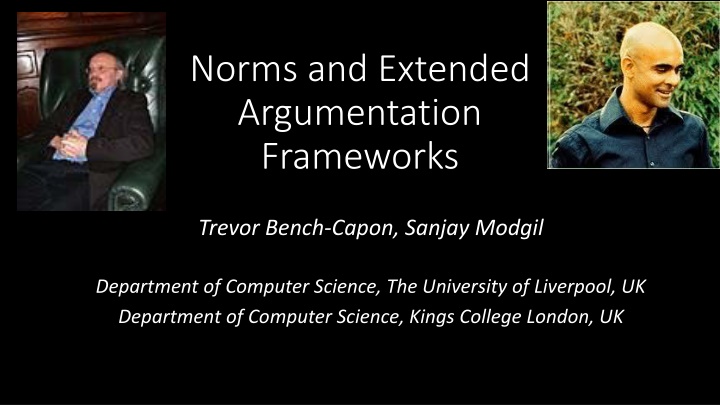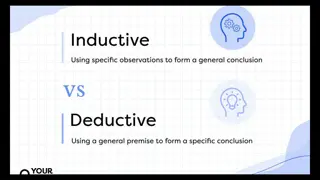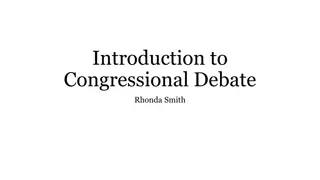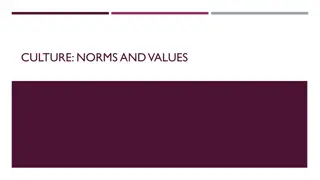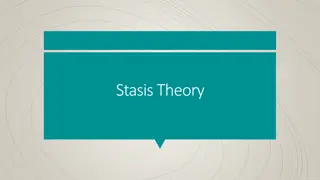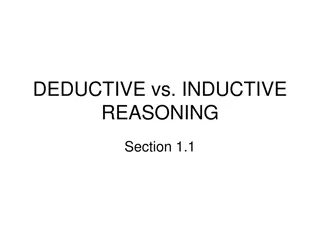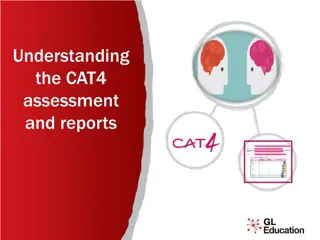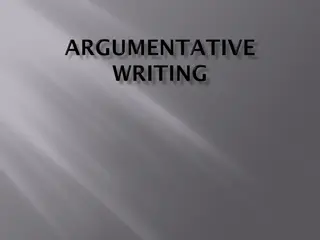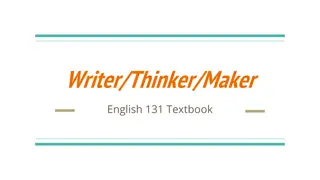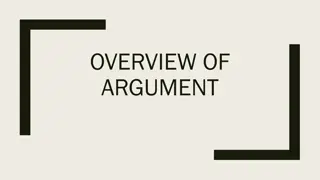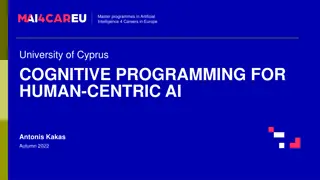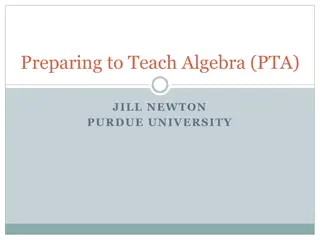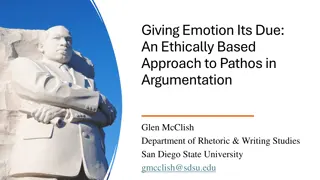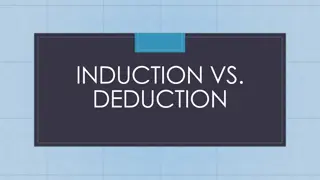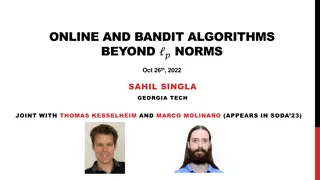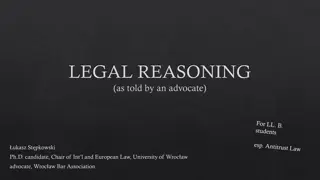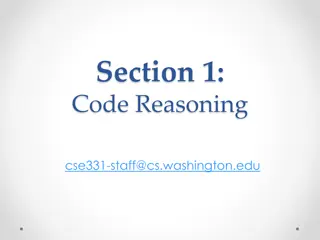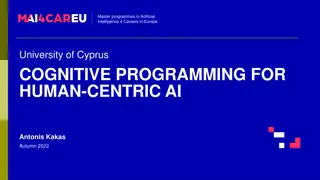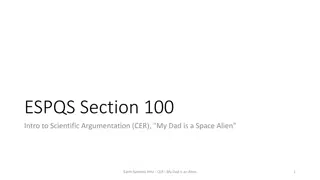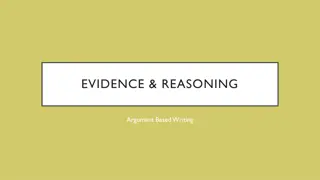Norms and Practical Reasoning Frameworks in Value-Based Argumentation
Norms play a crucial role in influencing behavior through practical reasoning. Practical reasoning involves using value-based argumentation frameworks to generate and evaluate arguments, as demonstrated in the parable of the Ant and the Grasshopper. The story highlights the importance of planning for the future and how norms can guide behavior towards long-term success.
Download Presentation

Please find below an Image/Link to download the presentation.
The content on the website is provided AS IS for your information and personal use only. It may not be sold, licensed, or shared on other websites without obtaining consent from the author.If you encounter any issues during the download, it is possible that the publisher has removed the file from their server.
You are allowed to download the files provided on this website for personal or commercial use, subject to the condition that they are used lawfully. All files are the property of their respective owners.
The content on the website is provided AS IS for your information and personal use only. It may not be sold, licensed, or shared on other websites without obtaining consent from the author.
E N D
Presentation Transcript
Norms and Extended Argumentation Frameworks Trevor Bench-Capon, Sanjay Modgil Department of Computer Science, The University of Liverpool, UK Department of Computer Science, Kings College London, UK
Overview Norms are intended to influence (not determine) behaviour They must play a role in practical reasoning reasoning about what to do. We follow Hare: in a novel situation, we need to reason from first principles, but having arrived at a conclusion we crystallise it into a not too specific or detailed form, so that its salient features may stand out and serve us again in a like situation without so much thought. In a novel situation we do practical reasoning without norms: but this reasoning can be encapsulated in a norm for future use Norms emerge from practical reasoning and then are used in practical reasoning
Practical Reasoning We use Atkinson and Bench-Capon s value based practical reasoning Situation represented as an Alternating Action Based Transition System Arguments are Generated using the Argumentation Scheme for Value Based Practical Reasoning Counter Arguments are generated using critical questions associated with that scheme Arguments are organised into a Value Based Argumentation Framework Arguments are evaluated according to the value preferences of the audience The long version of the paper shows how this works for the parable of the Ant and the Grasshopper https://intranet.csc.liv.ac.uk/research/techreports/tr2019/ulcs-19-001.pdf
Ant and the Grasshopper In Summer, when food is plentiful The ant works hard and gathers food for the winter The grasshopper sits idly singing In Winter there is no food The grasshopper asks the ant for food The ant refuses The grasshopper dies Moral: if you want to succeed tomorrow, you have to start working today. Those who do not plan for the long term will not succeed in the long term.
Norms from Ant and Grasshopper Given that survival is the most important value people will choose to act like the ant. This gives rise to the norm You should work in summer In future the norm can be used instead of going through the whole process An additional norm is required to punish transgressors: otherwise the temptation to freeload will lead to normative collapse You must not give food to a non-worker
Practical Reasoning in a VAF Arg1: Work to live Arg2: Play for pleasure If we prefer life we will choose to work If we prefer pleasure we will choose to play
VAF with Explicit value arguments Choosing a preference argument defeats one of the arguments (and the other preference) Two possible extensions: Prefer life and work Prefer pleasure and play
Extended Argumentation Framework Now the preferences attack the attacks, not the arguments Mazlow Now the preference defeats the attack. The preferred argument defeats the less preferred argument We can justify the preferences with other arguments Mazlow s hierarchy gives a reason to prefer life
Representing a Norm Now the norm can replace the Reasoning We cannot play because it is forbidden Punishment Preferences need not be considered if the norm is obeyed A preference for pleasure might defeat the norm, so there is a temptation to violate Norms need to be backed by sanctions
Representing An Exception An exception attacks the attack from the norm We are now free the choose between the actions according to our preferences. Both actions are permitted by the exception In a standard VAF the exception defeats the norm In an EAF the norm remains valid, although inapplicable
Fourth Amendment Protects the citizen against unreasonable search of person or papers A search is reasonable if there is probable cause and a warrant is obtained Sometimes urgency is such that a warrant cannot be obtained Evidence may be destroyed Evidence may be moved to another jurisdiction One such exception is for an automobile Carroll v US a 1925 case which involved a car transporting alchohol over the Canadian border.
Fourth Amendment Before the Fourth Amendment Either action was permitted Citizens and Police might have different preferences Fourth Amendment Prefers privacy and forbids search But there is an exception if a warrant is obtained
Automobile Exception Sometimes it may be impossible to obtain a warrant But law enforcement requires a search so there need to be exceptions It was established in Carrol that an automobile in transit may be such an exception
Situation after Opperman, Coolidge and Chadwick It was argued that the automobile exception should not apply if a warrant could be obtained Exception if there are lowered expectations of privacy No lowered expectations of privacy if automobile on private land (Coolidge) No lowered expectations of privacy for luggage in automobile (Chadwick)
Discussion: why EAFS? Norms are traditionally represented using deontic logic But there are alternatives: State transition diagrams popular in multi-agent systems Argumentation frameworks - as used in this paper Explicit, easy to understand, covers both emergence and use Norms can be justified using practical reasoning with value preferences But this reasoning can be encapsulated as an argument: the norm provides a reason for or against an action We need to represent exceptions In standard frameworks they appear as superior norms, defeating the general norm In extended argumentation frameworks they prevent the norm from having an effect The norm is not defeated
